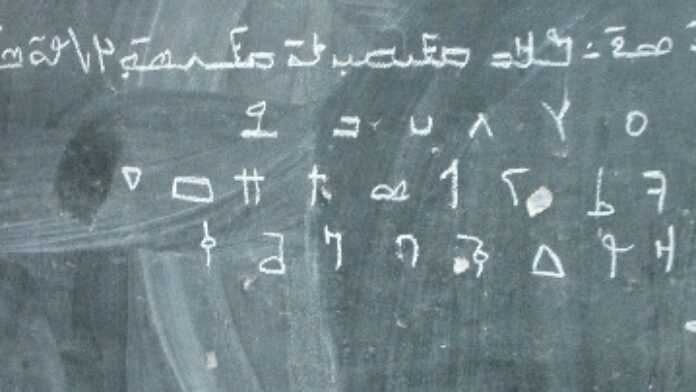
In October 2009, I came to Mali to learn to read. This may come as a surprise since West Africa is supposedly the world’s most illiterate region (“West Africa: Combating World’s Lowest Literacy Rates,” IRIN, 22 April 2009).
But it is the only place on earth where I can study the N’ko alphabet with people who actively use it.
I began studying N’ko last year while living in Kankan, Guinea and just resumed my studies this month in Bamako, Mali.
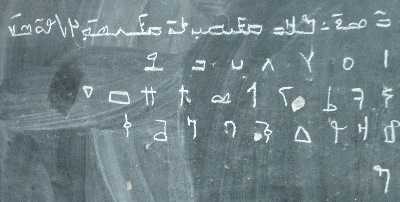 In 1944, Kankan native Souleymane Kanté (pronounced KAHN-tay) was living and working in Côte d’Ivoire. There he read Lebanese journalist Kamal Marwa’s remarks about African languages. Marwa wrote: “African voices are like those of the birds—impossible to transcribe” (Dianne Oyler, “Reinventing Oral Tradition: The Modern Epic of Souleymane Kanté,” 2002).
In 1944, Kankan native Souleymane Kanté (pronounced KAHN-tay) was living and working in Côte d’Ivoire. There he read Lebanese journalist Kamal Marwa’s remarks about African languages. Marwa wrote: “African voices are like those of the birds—impossible to transcribe” (Dianne Oyler, “Reinventing Oral Tradition: The Modern Epic of Souleymane Kanté,” 2002).
Kanté proved Marwa wrong. By 1949, he had invented a new alphabet in which to write his own language, Mandinka, and which could conceivably transcribe any language. The result was N’ko, which means “I say” in Mande languages.
I first heard about N’ko in the United States from academics working in Guinea and Mali. I was skeptical. I saw no need for another alphabet in francophone West Africa.
In the 1990s, I had seen Ivoirians use French characters to write letters to each other in Malinké. I had also seen Bibles published in Ivoirian languages in Abidjan by the Society for International Linguistics (SIL), which uses the International Phonetic Alphabet. African alphabets also existed in the region. Guineans used Arabic letters to write Pular in a transcription system called Ajami, and Tuareg-speakers used Tifinagh in the Sahel and Sahara. Why add another alphabet to the soup?
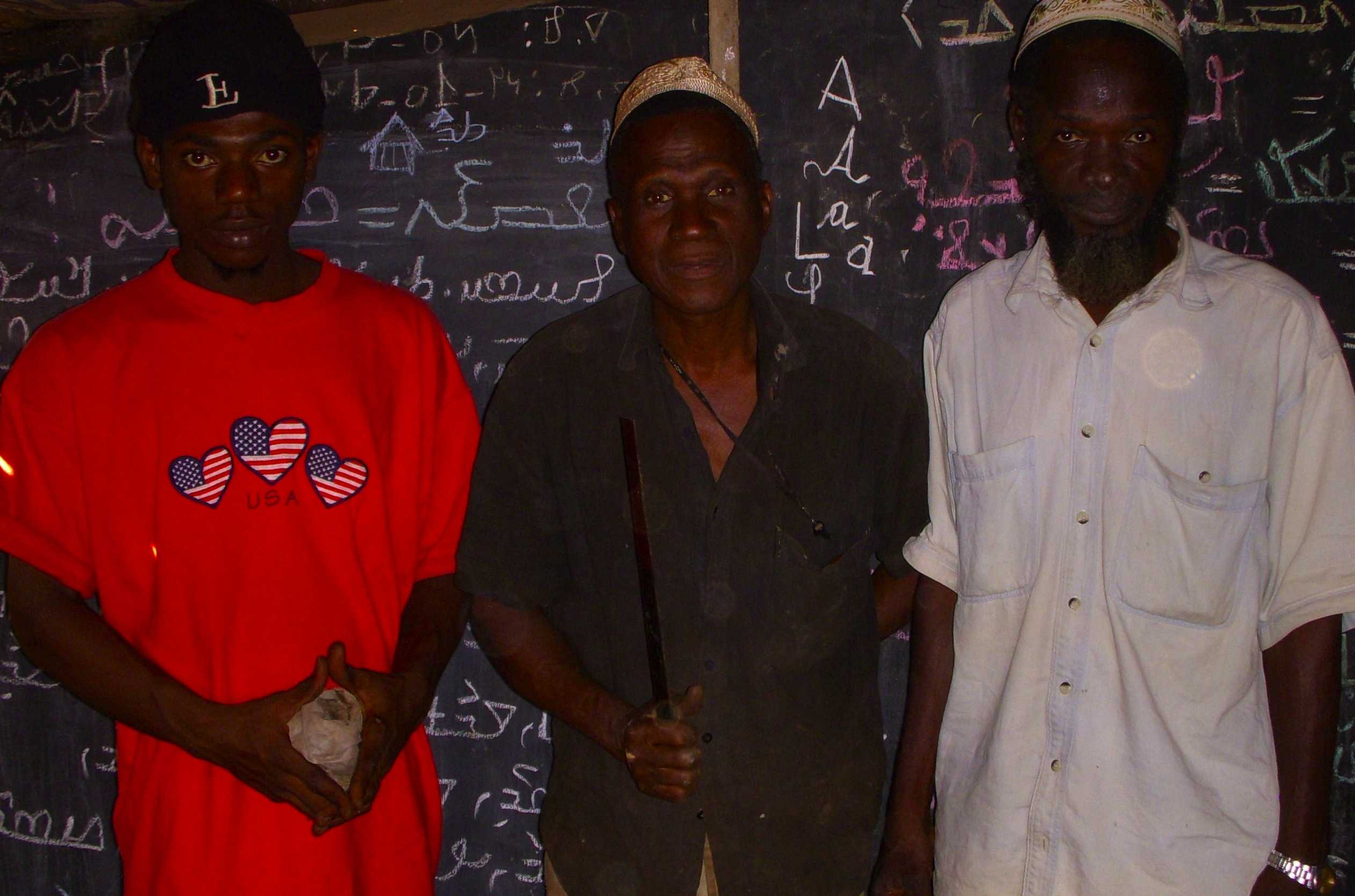 Well, imagine it’s your first day at school, and your teacher is talking to you in a language you don’t understand. It’s not the English you speak at home, but you’ve heard it before being spoken by people who have gone to school. And when you learn to write it, you do so in the Cyrillic alphabet. Ironically, you have to learn Russian just to learn to read and write when you could have both from the start in your native English.
Well, imagine it’s your first day at school, and your teacher is talking to you in a language you don’t understand. It’s not the English you speak at home, but you’ve heard it before being spoken by people who have gone to school. And when you learn to write it, you do so in the Cyrillic alphabet. Ironically, you have to learn Russian just to learn to read and write when you could have both from the start in your native English.
This may sound crazy, but it’s the way most education works in francophone Africa. Every school day, children whose families speak mostly unwritten African languages leave their homes to read and write in French.
Thus N’ko. Souleyemane Kanté created it to help promote literacy in African languages.
I understand his genius better now.
During my first few weeks in Kankan in October of 2008, my fellow Fulbright colleague, Eva Yerende, a professor of education teaching in the English Department, took me to see Kèmo Kanté (keh-MAW KAHN-tay), a local N’ko teacher.
We found him under a three-walled shelter at the back of the lot where he and his apprentices repair cars at the center of town. I routinely saw young men studying N’ko with him there for free. They brought their own pens and blank notebooks and copied the N’ko letters, words, and sentences that Kèmo wrote on the blackboards that hung inside his classroom. These blackboards were literally wooden boards painted black. There was no slate. Like N’ko itself, local people sustained N’ko with local resources.
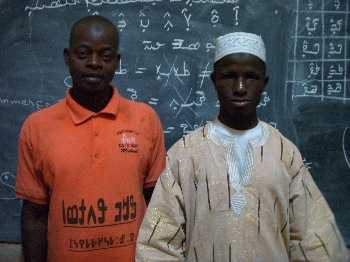 Kèmo’s shack was a makeshift academy. Many who studied there had never gone to school, at least not to the francophone schools that make up Guinea’s national educational system. Some had studied Arabic. But for whatever reasons, all found themselves marginalized from schooling in French. N’ko gave them, and me, a new chance at literacy.
Kèmo’s shack was a makeshift academy. Many who studied there had never gone to school, at least not to the francophone schools that make up Guinea’s national educational system. Some had studied Arabic. But for whatever reasons, all found themselves marginalized from schooling in French. N’ko gave them, and me, a new chance at literacy.
While living in Côte d’Ivoire from 1993-97, I had learned to speak an Ivoirian language called Jula after having studied the related Malian language, Bambara, at Indiana University for a summer. But my Indiana professor spent little time teaching tone. By tone I mean the way the pitch of your voice can, in some languages, change a word’s definition.
For native English speakers like myself, tone seems like something added on to words. You add tones to give different meanings to words that would otherwise be homonyms, as if tones were independent of words. But in Jula and Bambara, a change in tone can turn ‘home’ into ‘horse’, the verb ‘kill’ into ‘frying pan’.
Given my lack of familiarity with tone, I felt uncomfortable writing Jula in the phonetic alphabet with which I learned to write Bambara. In Côte d’Ivoire, I was merely fortunate to pick up the correct tones of words through assimilation.
But in Kankan, as I started to use N’ko to write Mandinka—a language closely related to Bambara and Jula—I felt more at ease. Kèmo Kanté put tone at the center of his teaching.
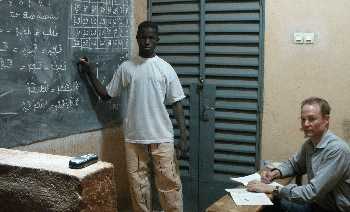 Instead of the three tones that linguists usually identify in Mandinka—high, low, and modulating (the high tone going unmarked)—there are four tones in N’ko: normal, high, modulating, and falling (with normal going unmarked). When vowels are long, tones lengthen, too. Normal linguistic transcription doesn’t mark this lengthening of tone. N’ko does.
Instead of the three tones that linguists usually identify in Mandinka—high, low, and modulating (the high tone going unmarked)—there are four tones in N’ko: normal, high, modulating, and falling (with normal going unmarked). When vowels are long, tones lengthen, too. Normal linguistic transcription doesn’t mark this lengthening of tone. N’ko does.
From trying to discern three tones in Mandinka, I went to hearing eight. This made more sense. Understanding tone was difficult for me, but it was better to acknowledge the complexity than to simplify or ignore it.
Now that I am in Mali, I study N’ko with Souleymane Diabaté (pronounced jah-bah-TAY), the twenty-six-year-old president of one of Bamako’s neighborhood N’ko associations. In addition to such associations, Mali and Guinea boast a small industry that produces and furnishes reading materials in N’ko on subjects from anatomy, astronomy, history, and mathematics to English, Muslim theology and N’ko pedagogy. Flashier books hail from Cairo, Egypt, from which Guinean expatriate Baba Mamadi Diané publishes and distributes them.
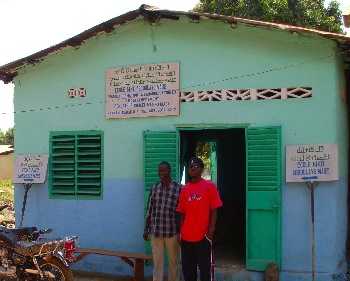 N’ko teachers also run their own schools, such as the one completed last year in Kankan by Nanfo Diaby (See photo). Classes occur mostly at night. Attending night classes shows a willingness to learn. If N’ko literacy is that important to those who study it, it is hardly superfluous.
N’ko teachers also run their own schools, such as the one completed last year in Kankan by Nanfo Diaby (See photo). Classes occur mostly at night. Attending night classes shows a willingness to learn. If N’ko literacy is that important to those who study it, it is hardly superfluous.
I look back on my dismissal of N’ko with embarrassment. All too often, supposedly “educated” Westerners like me, along with “educated” Africans, discount the creativity of African working-class people and peasants in this way.
At a time when “sustainable development” is all the rage and when adult literacy rates in countries like Guinea and Mali are low—29.5% and 26.2%, respectively (UNDP Human Development Report, 2009)—Africans are offering creative, sustainable approaches to literacy and education that deserve more attention.
I hope to revisit N’ko in future columns. But for now, a few choice words for anyone who might dismiss N’ko as I once did: “Read it.”

